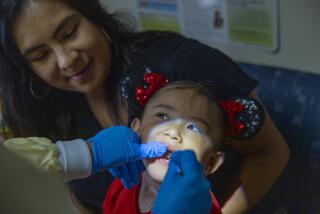The quest for the perfect smile
- Share via
The job of an orthodontist has morphed over the years, says Dr. Mark Yanosky, an orthodontist in Birmingham, Ala., and an adjunct assistant professor of orthodontics at the University of Alabama at Birmingham. It used to be that people just wanted well-aligned teeth, he says.
“Now, people come in and want well-aligned, perfectly white teeth with beautiful digital contours; they want a beautiful smile, beautiful facial aesthetics,” says Yanosky. He sums up the approach as “smile aesthetics.”
The emphasis is perhaps unsurprising. Magazine ads promote an array of tooth-whitening products. Television commercials tout Invisalign, a widely used, removable brace. And Internet come-ons for prettier, better teeth abound.
Meanwhile, gobs of studies show that people who are perceived to be attractive — known as the “what is beautiful is good” concept — receive greater social benefits.
This physical stereotyping leads people to assume that “attractive” individuals are more intelligent, are more qualified in job interviews, and have happier marriages. A 1974 study in the Journal of Research Personality and a 2001 study in the Journal of Social Psychology found that physical appearance even influences the verdicts and sentencing of defendants on trial.
Some research has focused specifically on teeth, finding that people make negative judgments about individuals with rotten teeth. A soon-to-be-published study expands on that research.
“We knew that was true, but we didn’t know how that applied to just having straight teeth or crooked teeth,” says Dr. Steven Lindauer, professor and department chairman of orthodontics at Virginia Commonwealth University in Richmond.
To evaluate the psychological and social benefits of orthodontic treatments and the importance of teeth in the assessment of physical attractiveness, Lindauer and his colleagues selected teenage volunteers age 10 to 16 years old; they chose the teens by standing outside a movie theater and offering movie vouchers to participants.
The researchers took the teens’ photos and digitally inserted straight or crooked teeth into the photos of each. They then showed the images to other study participants, so that one group saw a face with crooked teeth while the other group saw the same face with straight teeth. The reviewers were asked to rate what they thought about the faces based on popularity, sports ability, leadership, and intelligence.
In an upcoming report in the American Journal of Orthodontics & Dentofacial Orthopedics, the researchers say that those with straight teeth were rated 10% higher than the faces with crooked teeth in all of the categories except for smarts. In the intelligence category, the difference was not quite statistically significant, says Lindauer, but close. The results indicate a “modest social benefit” to having straight teeth, says Lindauer.
Dr. Lee Graber, an orthodontist in Vernon Hills, Ill., and past president of the American Assn. of Orthodontists, can vouch for the allure of perfect teeth.
He recently saw a patient — a physician — who didn’t like the appearance of her teeth and the way her lips were sinking. “She’s a pretty, smart physician — she shouldn’t feel that way, but she does,” says Graber.
“The data is there on the social science side that we live in a society where not looking abnormal, but looking good, is a valued commodity,” says Graber. “You can say you’re not supposed to judge a book by its cover, but we do it every day.”






